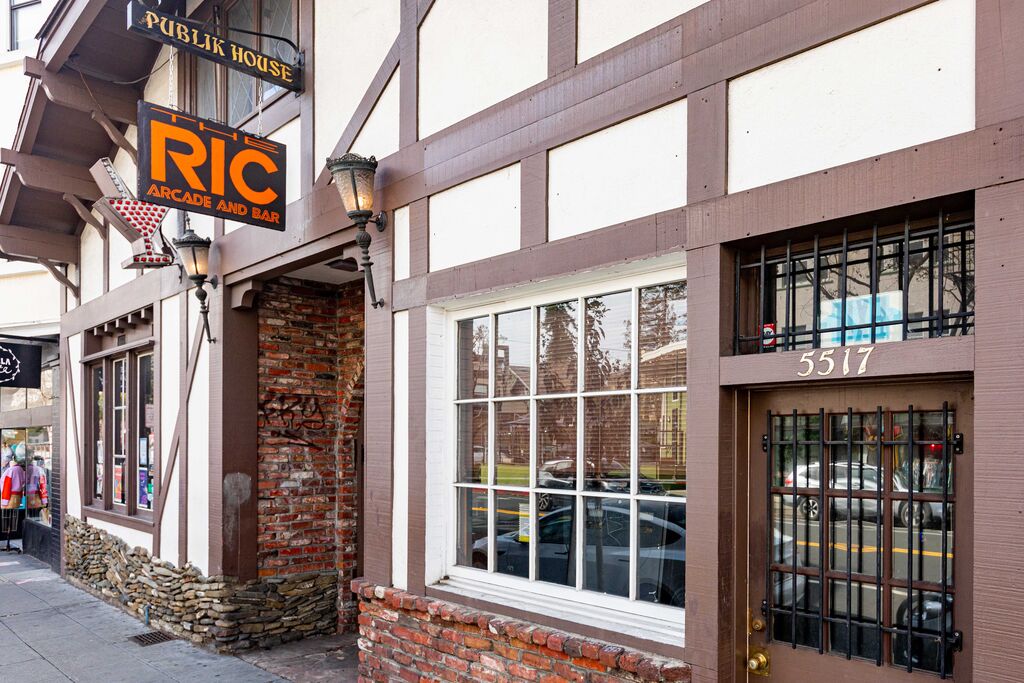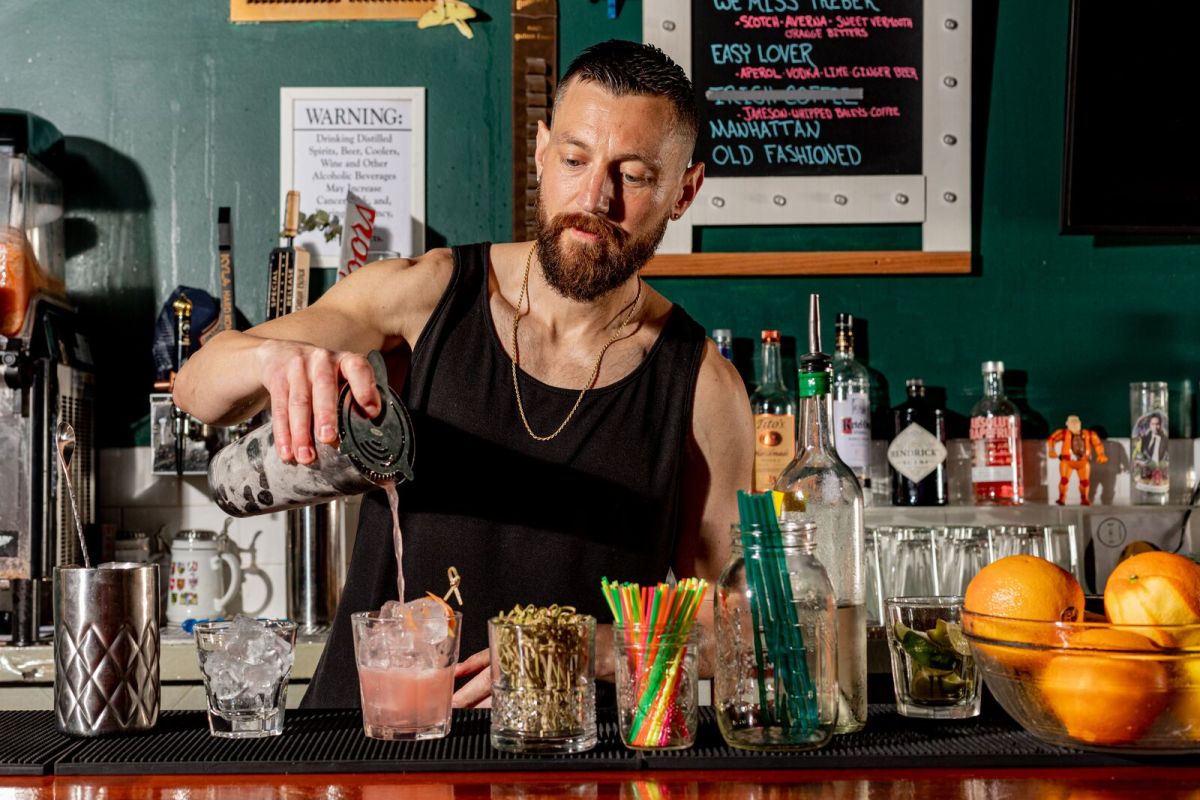Seven years ago, Scott Ayers bought a bar in Rockridge. The joint was divey, dispirited. The clientele was dying off.
The bar was called Ye Olde Hut, but for many decades it was simply called The Hut. Guests entered through a Tudor-style façade that promised folksy comforts, only to discover a dismal interior going to seed. An enormous brick fireplace, the stench of stale beer, and a few random barflies slumped like question marks on barstools.
Rockridge Improvement Club
5515 College Ave. Oakland
“It was a sinking ship,” said Ayers, a musician from Burlington, VT, who moved to Oakland in 1997 hoping to make it in the music business. In the 2000s he fronted a band called the Lovemakers and went by the moniker Scott Blonde. When iTunes, Spotify and other streaming services ate away at musicians’ royalties in the early 2010s, Ayers proposed to his friend, record producer and music lawyer Jeff Saltzman, that they buy a bar.
“Jeff was like, ‘Well, if you find a bar, let’s buy it.’” When Ayers approached the owners of Ye Olde Hut, “They were immediately ready to sell,” he said.
Today, Ye Olde Hut is gone. The façade at 5515 College Ave. is the same, but the bar is now the Rockridge Improvement Club, R.I.C. for short. It’s a tongue-in-cheek reference to the civic organization that built the structure in 1911, on a block that became the heart of the Rockridge commercial district.

The R.I.C. opened in June 2016 with Ayers as manager and an almost nightly presence, and Saltzman as co-owner. Business was slow at first, and, in March 2000, the bar closed for a year due to COVID. Today, however, the R.I.C. is a blooming success. There’s a younger clientele, a variety of weekly events, and a congenial, informal vibe.
Ayers, 47, has a youthful enthusiasm and he had a hunch that live entertainment would fly so he slowly built a weekly schedule: a Skee-ball tournament every Tuesday, Trivia Night each Wednesday (Ayers writes the questions and also hosts), a drag show on Thursdays, karaoke on Fridays, and deejays and live bands on weekends.
“I just wanted to bring something to the neighborhood that’s super-fun and different,” he said. “A little bit weird. A little bit David Lynch. A little bit Roy Orbison. A little bit queer. And just throw it all in this one thing and mix it up and see what happens.”
“Scott turned it around,” said Eric McNielCQ, a products director at a marijuana dispensary, who deejays a reggae vinyl night at the R.I.C. once a month. “He and Jeff made it a fun spot — especially post-COVID.”
Drag was the initial entertainment offering — “which is funny considering they’re two very straight rocker dudes,” said Ava LaShay, who commutes from Livermore to host the show each week. “Scott and Jeff are so supportive. At our very first show, one of the bartenders came in drag to support us, which was really cute. They want us to feel safe there.”

Stripping off the grit and muck that accrued during The Hut and Ye Olde Hut eras took two months. The bar’s interior went from dank and dour to quirky and kitschy, with velvet paintings of cougars and unicorns, and two Christmas trees that stay up all year. Bob Ross’s “The Joy of Painting,” usually muted, plays on TV when there’s not a sports game to watch.
Behind the bar there’s a glossy photo of a young Christopher Walken — seemingly the bar’s patron saint and spirit animal. And, in the tiny storefront next door, where Open Mind Music used to be, Ayers installed a game room/arcade.
All those changes are paying off. The R.I.C. is far more popular than the Ye Olde Hut was in its dying days. Ayers said that when the bar reopened in March 2021, after the pandemic shutdown, business went up by nearly 50%. Saltzman credits Ayers with that success: “Scott’s just a super-friendly and super-nice guy. When he goes away we don’t do as well,” he said.
Not everyone is thrilled with the R.I.C. Saltzman remembers that when the bar opened, he and Ayers got static for the new name, the irony of which escaped most people. “It seemed so snotty, you know? People were like, ‘Ohh, you think you’re gonna improve Rockridge, huh?’ ”
SF Eater ran a piece lamenting the demise of another dive bar, and mischaracterized the Rockridge Improvement Club as, “dedicated to craft cocktails.” The Ye Olde Hut diehards perceived a stench of bourgeois, pinkie-finger-in-the-air elitism. “We actually had people shoot through the windows with BB guns and put bags of crap in front of the door,” said Saltzman.

Ayers originally thought of calling the bar The Prancing Pony, after the roadside inn where Frodo goes to meet Gandalf in The Lord of the Rings. Rockridge Improvement Club ultimately won, because it echoes the civic organization that built the Craftsman-style structure in the early 1900s.
Rockridge was brand-new back then; the area was developed in response to the thousands of San Franciscans displaced by the 1906 earthquake and fire.
“There was always the rumor that the place was originally a temperance club,” said Ayers. The organization’s full name was the Vernon-Rockridge Improvement Club, Vernon Park being the original name for the area west of College Ave. Starting in 1914, the club began publishing a newsletter, the Bulletin, several editions of which survive in the Oakland History Room of the Oakland Public Library. None of them mentions temperance or warns of the depredations of demon booze.
Rather, the club raised money and rallied support for civic improvements such as schools, a branch library, tree planting, street lighting and sidewalk paving.
“We do not blow our horn about what we do,” a club officer wrote in the Bulletin in 1915. “We just do it because it needs to be done for the good of the district.”


The clubhouse at 5515 College Ave. had a kitchen, a 12×14-foot stage, dressing rooms, and a 30×40-foot main hall with a maple floor. It was rented out for weddings, religious services, card parties, plays, dances, and concerts. Neighborhood groups like the Kales Avenue Whist Club and Taft Avenue Sewing Club met there.
In 1920, the Improvement Club vacated the building and The Hut opened. Prohibition became law early that year, so The Hut, calling itself a “recreation club,” sold milkshakes and soft drinks, ice cream, cigars, and cigarettes. No liquor. It had a billiard table, and rooms for chess and for reading. “Applications for membership may be made by persons of good character,” announced an ad in the Bulletin. Prohibition was repealed by certification of the 21st Amendment on Dec. 5, 1933, so it’s a safe bet The Hut sold booze soon thereafter.
When construction began on BART and Highway 24 in the mid-1960s, hundreds of homes and businesses were razed in Rockridge and Temescal, and longtime residents fled to Contra Costa County. The neighborhood was depressed, crime spiked, but The Hut stayed open. The people who’ve lived all their lives in Rockridge — before the demolition — remember Rockridge as homey, unpretentious, not the upscale destination of today.
“I thought it was a little village,” said Catherine Griffing. “This fun, tiny little village.” “My dad would take us walking at night down to The Hut,” remembers Claire Lomax, who lives on Harwood Avenue in the house her grandfather bought in 1913. She says that in the 1950s, “The Hut had a newsstand and cigar stand in front.” A decade later, the bar was sketchier. “In my teens I walked by it daily on my way to Tech [Oakland Technical High School],” said Annette Floystrup. “The Hut was known to be a place where biker gangs hung out and heroin was sold.”
Occasionally, old habitués of The Hut wander into the R.I.C. and tell stories. “Apparently there was a guy who lived upstairs in the bar for a long, long time,” said Ayers. “There’s ghost stories and stories of people dropping dead at the bar. All kinds of, ‘This place is haunted’ or whatever.” He adds: I’ve never seen anything like that.”
Ayers said he’s happy with the energy the R.I.C. generates today and likes that it’s become a performance space and community gathering spot — not just a drinking establishment or a sad refrain on Ye Olde Hut. “People don’t come here to sit and get hammered,” he said.

